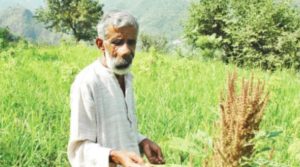
Vijay Jardhari
Vijay Jardhari is a farmer and social activist of Jardhargaon, a village in the Tehri-Garhwal district of Uttaranchal in north India. In the late 1980s, he realized that modern agriculture was destroying traditional farming. In Garhwal, there were once more than 3000 varieties of rice alone, but just a few varieties were promoted by the Green Revolution. The yields of the new varieties were actually low, soil health was declining, and farmers had to use ever-increasing amounts of fertilizers and pesticides.
Jardhari and his friends visited villages in the region to learn more about traditional varieties of seeds. They found many indigenous rice varieties in the valley of Ramasirain, Uttarkashi district. Compared to modern varieties, they were more nutritious and better suited to local requirements and conditions. The farmers were growing them without the use of chemical fertilizers and pesticides.
The farmers in Ramasirain were also avoiding monocultures. They were sowing 12 different grains (cereals and legumes) on one field, ensuring protection against drought and crop failure. This also maintained soil fertility and replenished nitrogen. They had a year-round supply of food since they were harvesting the crops at different times of the year. This tradition of agriculture was called ‘Baranaja’ which means 12 anaja or grains (Baraha anaja).
Jardhari and his farmer-friends made Jardhargaon the base for a Beej Bachao Andolan (BBA) or Save Seeds Movement. The objective of BBA was (and continues to be) the revival of traditional agricultural practices and conservation of indigenous seeds. In the words of Jardhari, “BBA aims to value traditional knowledge and wisdom and uphold and upkeep the Himalayan biodiversity (especially the local food plants), seek a respectable status for small farmers in the hilly regions and preserve the sociology of traditional agriculture and agricultural practices.”
Through food marches and meetings, BBA created awareness about the importance of protecting traditional seeds. BBA also persuaded farmers to discontinue growing cash crops like peas, potatoes and soybean and adopt indigenous practices like Baranaja. BBA motivated the farmers to adopt organic farming and avoid chemical fertilizers and pesticides. The movement called for local management of the seed market instead of control by giant multinationals.
The use of traditional farming methods and seeds has increased yields. People’s health has improved thanks to a more balanced diet. More and better fodder has improved the health of livestock. At the same time the soil has become healthier. The local agriculture department has also accepted the Baranaja scheme.
BBA has saved about 350 varieties of paddy, 220 varieties of kidney beans or rajma (beans), eight varieties of wheat, and so on. They also promote natural pesticides like neem, ash, and cow’s urine. BBA has also promoted millets and organic farming. BBA has helped women’s Self Help Groups (SHGs) in the villages to set up seed banks of traditional crop varieties. Many women farmers have adopted the traditional methods. The movement started by Beej Bachao Andolan has now spread to many parts of Uttaranchal.
BBA suffered a major setback in 2006, when it lost its key member, journalist and writer Kunwar Prasoon. The movement has sustained itself without financial support from government. Despite all odds, the BBA members have not lost the zeal to collect and preserve the traditional seeds.
Jardhari recalls that the people of Garhwal used to say that millets were for the poor. Now they are surprised by the consumption of traditional millets by the more prosperous sections of the society. “We are asking the villagers to grow traditional crops as they have greater nutritive value and they should cultivate and consume it for the sake of their health,” says Jardhari.
Jardhari had participated in the Chipko Movement to save the forests and was later involved in protesting against mining activities in Nahi Kalan in Dehradun (Uttarakhand). In the 1980s, however, he decided to dedicate his life to the revival and conservation of traditional seeds. His farm itself is a prime example of the use of indigenous varieties.
In a 2012 interview, Jardhari said, “The rapidly deteriorating status of farming in hilly regions across the Himalayas and the negligence and disrespect to local food especially in the Garhwal region inspires me to work to promote and conserve the biological diversity of the region.”
Vijay Jardhari was awarded the Indira Gandhi Paryavaran Puraskar in 2009.
Afterword: Several short videos on Jardhari and BBA are available on YouTube.

I am working with native seed producers and seed conservationists. Life is not easy for them, as the market is full of hybrid seeds and they are cheap. Several seed banks do exist and they require good support and proper control strategies. Spurious seed marketeers compete with them putting up wrong labels. Hence, it is difficult to distinguish between the genuine and the spurious. I have heard how seeds were conserved and distributed by women in the past. It was almost like a religious practise of sharing native and healthy seeds. It is no longer in existence now, under the changed circumstances, where seeds are bought from the monopolists. Unless agriculture is given its due importance and farmers are respected, saving seeds has being a dying art.